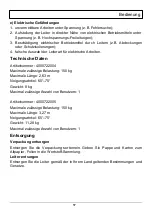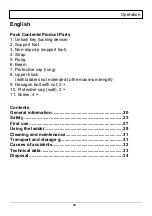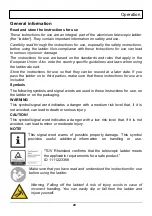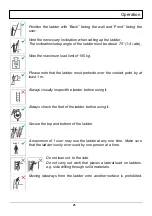
Operation
25
the ladder.
− Always position the ladder on its bases and not on the rungs or steps.
− Do not position the ladder on slippery surfaces (e.g. ice, smooth
surfaces or very dirty, solid surfaces) unless additional measures
have been taken to prevent the ladder from slipping or adequately
cleaning dirty spots.
− Never exceed the ladder’s payload. The ladder’s maximum load-
bearing capacity is 150 kg.
− Do not lean too far away from the ladder when you are standing on
it. You should always stand with both feet firmly on the same step
and with centre of your body (belly button) between the bars.
− Do not climb up the ladder to any great heights without additionally securing
the ladder. Fasten the ladder or use an appropriate setup to secure the
stability.
− Do not stand on the top three rungs of the ladder. Caution: the top
bracket is not a rung. Do not stand on the top bracket.
− Only use the ladder for simple and short work.
− Do not use the ladder for work involving live parts. The
ladder is made of conducting material. Use non-
conducting ladders for unavoidable work involving live
parts.
− Do not use the ladder outdoors in poor weather conditions, e.g. in strong winds
or storms.
− Make sure that children do not play with the ladder. Do not leave a set up
ladder unattended.
− Keep children away from the ladder.
− Lock doors and windows in the work area if possible, but not emergency exits.
− Always climb up and down with your face towards the ladder.
− Hold firmly onto the ladder when ascending and descending. Hold
the ladder when working or take other safety measures if this is not
possible.






































